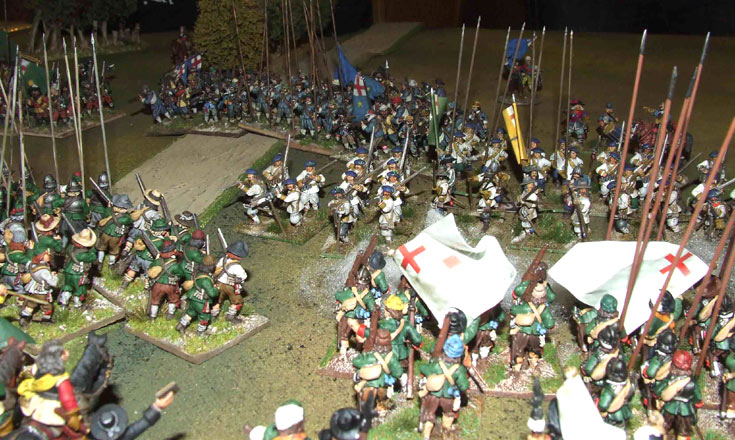
Fareham, 1643
4th February 2010, Comments Off
The English Civil War, Very Civile Actions, 28mm
We all enjoyed our Marston Moor refight last month, so this week we decided to stage another smaller English Civil War battle, to test out a few tweaks in the rules. This was a straightforward clash with four regiments of foot a side (each of 48 figures), supported by four 12-figure regiments of horse. All the foot were rated as “Trained Bands”, apart from one “Seasoned” regiment a side, while the horse were all “Harquebusiers”, except one Royalist “Cavalier” regiment, and Sir Arthur Hesilrige’s Parliementarian “Lobsters”. Sir William Waller led the forces of Parliament, while Lord Hopton commanded the “malignants”.
All the foot were rated as “Trained Bands”, apart from one “Seasoned” regiment a side, while the horse were all “Harquebusiers”, except one Royalist “Cavalier” regiment, and Sir Arthur Hesilrige’s Parliementarian “Lobsters”. Sir William Waller led the forces of Parliament, while Lord Hopton commanded the “malignants”. Both sides had no hesitation in advancing into contact – no lurking behind hedges here – and the battle soon came down to musketry and push of pike. Both commanders had grouped their cavalry on one flank, and all four cavalry regiments charged, wheeled, counter-charged and crossed swords in a satisfying but largely ineffectual way.
Both sides had no hesitation in advancing into contact – no lurking behind hedges here – and the battle soon came down to musketry and push of pike. Both commanders had grouped their cavalry on one flank, and all four cavalry regiments charged, wheeled, counter-charged and crossed swords in a satisfying but largely ineffectual way. Actually, that isn’t quite true – one regiment of Parliamentarian horse was routed fairly early on, and although it rallied on the table edge it never really got back into the fight. The “Lobsters” performed well, as did Sir Henry Bard’s “Cavaliers”. Still, after two hours of gaming, neither side had a clear advantage.
Actually, that isn’t quite true – one regiment of Parliamentarian horse was routed fairly early on, and although it rallied on the table edge it never really got back into the fight. The “Lobsters” performed well, as did Sir Henry Bard’s “Cavaliers”. Still, after two hours of gaming, neither side had a clear advantage. On the Parliamentarian right a pesky unit of Royalist dragoons was driven off, but the two Royalist white-coated regiments proved a much tougher challenge. The more seasoned of the two – Col. Lisle’s foot – wore down the London “Trained Bands” facing them, and then charged home.
On the Parliamentarian right a pesky unit of Royalist dragoons was driven off, but the two Royalist white-coated regiments proved a much tougher challenge. The more seasoned of the two – Col. Lisle’s foot – wore down the London “Trained Bands” facing them, and then charged home. The Londoners were only saved by a counter-charge by the other “seasoned” unit on the field – John Hampden’s green coats, who halted the Royalists and drove them back. Over on the left the infantry fight never amounted to much more than an exchange of musketry, as the hesitant Royalists lacked the will to close with the Parliamentarian foot.
The Londoners were only saved by a counter-charge by the other “seasoned” unit on the field – John Hampden’s green coats, who halted the Royalists and drove them back. Over on the left the infantry fight never amounted to much more than an exchange of musketry, as the hesitant Royalists lacked the will to close with the Parliamentarian foot. In fact the whole battle was pretty indecisive, which is really what we’d expect from such well-matched forces. Next time though, instead of a small set-piece battle we’ll be a little more adventurous and try out a scenario sent to me by Bob Giglio in the States – the Battle of North Petherton (1644). Still, indecisive or otherwise, this period is always enjoyable, and The Perfect Captain’s rules did exactly what we wanted, producing a fast-paced and challenging game.
In fact the whole battle was pretty indecisive, which is really what we’d expect from such well-matched forces. Next time though, instead of a small set-piece battle we’ll be a little more adventurous and try out a scenario sent to me by Bob Giglio in the States – the Battle of North Petherton (1644). Still, indecisive or otherwise, this period is always enjoyable, and The Perfect Captain’s rules did exactly what we wanted, producing a fast-paced and challenging game.

